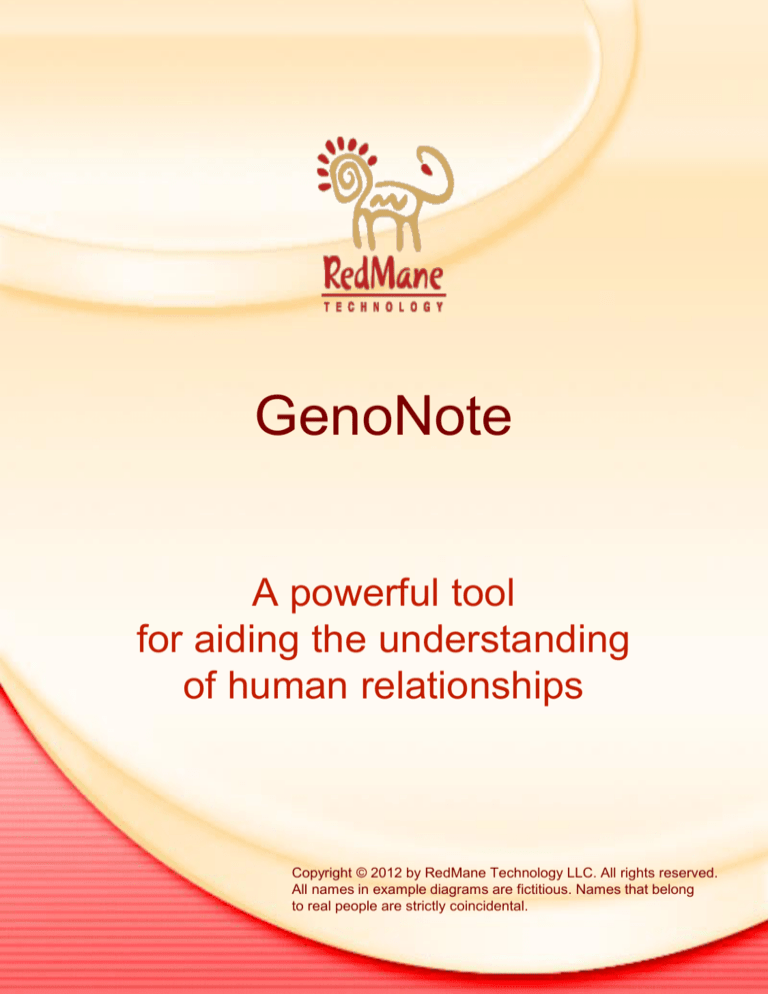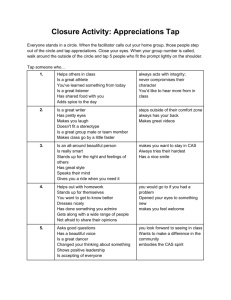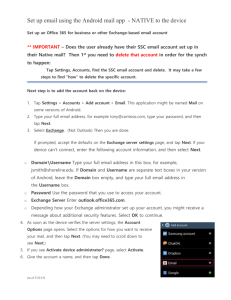
GenoNote
A powerful tool
for aiding the understanding
of human relationships
Copyright © 2012 by RedMane Technology LLC. All rights reserved.
All names in example diagrams are fictitious. Names that belong
to real people are strictly coincidental.
Introduction to GenoNote
GenoNote creates
diagrams called
genograms that
clinical professionals
use to map human
relationships.
With GenoNote, you
create digital diagrams
that you can update
and refer to on the go,
replacing traditional
paper genograms.
With GenoNote, you can create diagrams collaboratively with clients
during clinical interviews. As you work with GenoNote, you can toggle the
diagram view to a client-friendly version that uses icons instead of
symbols, making diagrams easier for non-clinical people to understand.
With GenoNote, you can create diagrams that—
Show the structures of families and households at a glance
Represent relationship dynamics
Flag history of abuse and show influences within groups
Highlight significant individual characteristics, including health issues,
abusive relationships, and other important attributes about an
individual.
The information in this guide will help you use GenoNote to create and
work with genograms for your clients and their families.
2
Contents
Introduction to GenoNote
The GenoNote toolbar
2
4
Quick steps for creating a diagram
Creating a GenoNote diagram
Adding a person
5
6
7
Adding details about a person
8
Tracking cultural information
9
Adding a photo to a person
10
Tracking personal characteristics
11
Changing information about a person
Adding a relationship
12
13
Adding more people and relationships
14
Changing, deleting, or hiding a relationship
Identifying household groupings
16
Highlighting a person’s relationships
Changing view types
Emailing a diagram
17
18
Understanding GenoNote symbols
Printing a diagram
15
19
20
21
Getting help with GenoNote
About RedMane Technology
22
23
Quick reference: Genogram symbols
Quick reference: Client-friendly symbols
3
The GenoNote toolbar
You start most of your work with diagrams from the GenoNote toolbar at
the top of the workspace.
Print the diagram
with family, household,
and individual info
sheets and a legend
Select a family diagram
or create a new one
Select or add a household
to the diagram
Display a legend of symbols
and their meanings
Edit or delete the family group
Email the diagram with family,
household, and individual info
sheets and a legend
Switch between genogram
and client-friendly notation
Open this help guide
Tap one of the icons on the GenoNote toolbar to create,
edit, print, or email a diagram.
4
Quick steps for
creating a diagram
Creating a genogram in GenoNote comprises these basic steps.
This help guide provides information about how to create and
work with GenoNote diagrams and their elements.
1. Create the diagram.
2. Add the first person to the diagram.
3. Provide details about the person.
4. Add relationships and more people.
5. Identify household groups.
5
Creating a GenoNote diagram
You start creating a diagram by defining a family and the first family
member. You can also edit this information later by tapping the pencil
icon at the top left side of the toolbar.
1. Tap the Family icon in the toolbar.
2. Type a name for the family unit and a description.
3. Type the
name of the
caseworker
who obtained
the family info
as the
Interviewer.
4. Record the name of the person who provided the
information as the Interviewee and tap Done.
Next, you will add the first family member to the diagram.
6
Adding a person
When you create a new diagram, GenoNote opens the Add New Person
box. At any other time, tap an existing person who has a relationship with
him or her to add the new person to the diagram. As you define the
relationship, you add the new person to the relationship.
To add a new person, you must enter
a first and last name.
All other information is optional. Provide any optional information as
described on the next page of this help guide.
Tap Done when you finish to add the person to the diagram.
7
Adding details about
a person
While GenoNote only
requires a first and last name
to define a person, you can
add details about the person
to provide a more robust view
of the person’s personality,
character, and challenges.
To add or change details
about a person in the
diagram, tap the symbol twice
and then tap the pencil icon.
Add optional details about the person:
Type a year or month/day/year for the dates of birth and death or the
age. You can type two-digit months and days without slashes or dashes.
Tap the blue plus sign next to Religion to specify religious affiliation OR
if the person’s religion is not on the list, type it directly into the box.
Tap the blue plus sign next to Ethnicity to specify the person’s ethnicity
or race OR type one or more ethnicities or races directly into the box.
Tap the blue plus sign next to Characteristics to select one or more
attributes to describe the person, such as Fragile Health or Physically
Violent.
Type notes about the person in the Notes box.
Associate a photo with the person from the Photos or Camera Roll app
or take a photo with the iPad camera.
To focus the diagram on this person, slide the Focus bar to Yes.
GenoNote surrounds the symbol for the person with a red box.
Tap Done when you finish to add the person to the diagram.
8
Tracking cultural information
With GenoNote, you can track
cultural information about the
people in a diagram, such as
their ethnic background and
religious affiliation. Labels that
indicate these attributes are
appear below a person’s
symbol.
To select religious affiliation
1. Tap the blue plus sign next to
Religion.
2. Tap the religion the person
practices.
3. Tap Done after selecting a religion.
To select ethnicity
1. Tap the blue plus sign next to
Ethnicity.
2. Tap the ethnicity or race of the person.
If the person’s ethnic identity is multiracial, select two ethnicities.
3. Tap Done when you finish.
9
Adding a photo to a person
You can associate a photo with a person in a diagram. You can
select a photo from the gallery or use your iPad camera to take
a photo of the person.
1. Tap the symbol for the person twice
and then tap the Pencil icon.
2. Tap the blue plus sign next to Image.
Choose Camera or Photo Album.
3. Follow the instructions on screen to
take or select a photo.
4. Tap Done when you finish.
Photos appear only when you display
the diagram in Client-Friendly Notation.
10
To delete a photo from a
person, tap the red X on the
Image box in the Edit
Person Details box.
Tracking personal
characteristics
In GenoNote diagrams, you can flag individuals with
characteristics that you want to track, such as health issues, a
history of abusive behavior, or issues such as substance abuse.
When you select one or more
characteristics to flag, icons that represent
those characteristics appear next to the
symbol that represents the person on the
diagram. For example, the ambulance and
starburst icons next to this diagram
indicate that Emory Davidson is in fragile
health and has mental health issues.
To add icons that indicate
personal characteristics, select
the person. Tap the blue plus
sign next to Characteristics to
select one or more attributes
to add to the person.
11
Changing information
about a person
You can change or add to the information about a person in a
diagram at any time.
1. Double tap the person whose information you want to
add to or change.
2. Tap the Pencil icon to change or add information about
the person.
3. Change or add information about the person.
4. Tap Done when you finish.
12
Adding a relationship
You can indicate significant
relationships among the people in a
diagram, such as marriages and
parental and child relationships, as
well as indicating the nature of
relationships, such as abusive or
supportive.
1. Long tap the symbol of an
existing person to whom you want
to add a relationship.
2. Tap the category of the
relationship, such as Child.
3. Select the specific type of
relationship, such as
Adopted Child.
4. Enter the starting and ending
dates of the relationship, if
known.
5. Tap Done to save the
relationship as part of the
diagram.
To make changes to a relationship, tap one of the persons in the
relationship twice and then tap the People icon in the box that appears.
Select the relationship to change and edit the details accordingly. To
delete rather than change the relationship, tap Delete Relationship to
remove the relationship from the diagram.
13
Adding more people
and relationships
You add new people to a diagram by adding selecting an
existing person who has a relationship with the new person.
1. Long-press the symbol for the person
who has a relationship with the new
person you want to add and select the
type of relationship.
2. Enter info about the new person. If no details
are available, tap Select Existing Person and
select Unknown Male or Unknown Female.
3. If known, provide the start and end dates of the
relationship.
4. Tap Done to add the person and relationship to
the diagram.
14
Changing, deleting,
or hiding a relationship
You can change or add information to a relationship, or delete
the relationship from the diagram. You can also hide a
relationship in the diagram.
To start, tap a person symbol twice to change, delete, or hide a
relationship that he or she is involved in.
To change information about the
time period of the relationship or to
delete the relationship, tap this icon
and select the relationship.
To hide the relationship, tap this
icon and select the relationship
to hide.
15
Identifying household groups
With GenoNote, you can identify the household groups to which
people in the diagram belong. GenoNote displays a house icon
and ID number next to each member of the household. You can
associate as many persons to one household as necessary.
1. Tap the House icon on the
GenoNote toolbar to define or
select a household.
2. Type a name and description
for the household group or
tap Select Existing
Household.
3. To select the members of the household from the people in
the diagram, tap the blue plus sign next to Members.
4. After you select all members of the household from the list of
people in the diagram, tap Done.
In this diagram, the house icons with
the number 1 indicate that Philip
Evans and Mary Ann Evans are
members of the same household.
16
Highlighting a
person’s relationships
GenoNote can emphasize the relationships of one person in the
diagram to help you focus on only his or her relationships.
To highlight the relationships of only one person, tap the symbol
or icon that represents the person.
In this diagram, we tapped the icon that represents Alicia Lewis.
GenoNote displayed Alicia’s relationships as bold and bright pink
in color to emphasize them. To return the relationship lines to
their normal appearance, tap the symbol or icon for the person
again.
17
Changing view types
You can view a GenoNote diagram as a traditional genogram or
in a client-friendly format with icons that look like humans instead
of genogram symbols. If the diagram information includes photos
of people, the photos appear in Client-Friendly Notation view.
1. Tap the Settings icon.
2. Tap the type of view you want.
GenoNote displays the
diagram in the view type
you selected.
18
Understanding
GenoNote symbols
You can display a legend of the symbols that represent people,
relationship types, and personal characteristics. You can also
display a legend for the icons used in the Client-Friendly
Notation view.
Tap the Information icon to see the list of icons that can
appear on a diagram in the current view type.
When you finish your review of
GenoNote symbols, tap Hide.
This help guide includes a quick reference of all
genogram symbols and client-friendly notation icons.
19
Printing a diagram
You can print any GenoNote diagram on an AirPrint printer
associated with your iPad.
Tap the Printer icon on the GenoNote toolbar and then tap Print
when you see the preview of the diagram.
20
Emailing a diagram
You can email any diagram from GenoNote. Tap the document
icon to open an email. GenoNote creates a PDF of the diagram
in the current view type as an attachment to the email. The PDF
includes the same pages that you see when you print the
diagram from GenoNote.
After you compose the email, tap Send to email it with the
diagram as a PDF attachment.
21
Getting help with GenoNote
Have a problem with GenoNote? Let us know so that we can
help solve it!
If you just need information about a GenoNote feature or symbol,
you may find it in this help guide. You can display this any time
by tapping the Help icon on the GenoNote toolbar and then
tapping Help Guide.
If you experience a problem while using GenoNote, follow these
steps to contact RedMane Technology for support:
1. Tap the Help icon.
2. Tap Email Support.
3. GenoNote opens an email and attaches a picture of the
current screen to the email. Describe the steps you took and
what happened.
4. When you finish, tap the Send button. RedMane will respond
as soon as possible to help solve the problem.
22
About RedMane Technology
RedMane Technology is a company focused on human services.
We provide tools and services to help human services agencies
and professionals perform at their best.
RedMane is a systems integrator with a solid track record in
developing successful human services applications for State and
Local Government. Agencies typically turn to RedMane when
they are looking for new and innovative ways to leverage
technology to improve the delivery of their services. RedMane
brings domain and technology expertise and repeatedly
demonstrates the ability to deliver successful solutions within a
given timeframe and budget.
Please visit us at www.redmane.com.
23
GENONOTE QUICK REFERENCE
Genogram symbols
Persons
Relationships
Type of relationship
Male
Female
Casual short-term
Deceased
Committed long-term
Unborn (unknown gender)
Common law marriage
Miscarriage
Marriage
Abortion
Other
Personal characteristics
Child relationship
Appropriate family roles
Adopted child
Fragile health
Biological child
Mental health issues
Unborn child
Physically violent
Miscarriage
Physically disabled
Abortion
Nature of relationship
Strong communication skills
Strong cultural identity
Emotional abuse
Substance abuse
Neglectful abuse
Substance abuse in recession
Physical abuse
Suspected substance abuse
Sexual abuse
Characteristics of relationship
Close
Preventative health practices
Close—hostile
Emotional stability
Hostile
Sufficient resources provider
Cut off
Supportive relationship
Discord
Distant
Distrust
Hate
Indifference
GENONOTE QUICK REFERENCE
Client-Friendly Notation symbols
Males
Females
Man
Woman
(18 years old or older)
(18 years old or older)
Boy
Girl
(1–17 years old)
(1–17 years old)
Baby boy
(Less than 1 year old)
Baby girl
(Less than 1 year old)
Unknown man
Unknown woman
Pregnancies
Unborn child
Abortion
Miscarriage








